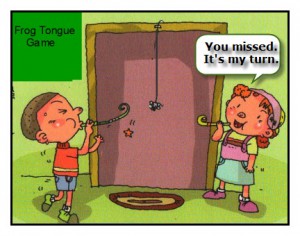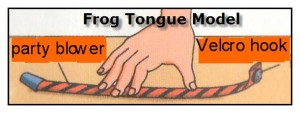 Frogs have a long tongue that can extended far out of their mouths.
Frogs have a long tongue that can extended far out of their mouths.
A frog’s tongue is about one-third the length of its body.
In the photo, the child’s tongue barely extends past her lips. If were one-third the length of her body, the child’s tongue would touch her belly button.
Yikes! How would she get such a long tongue to fit inside her mouth?
How do frogs store their long tongues in their mouths? Unlike your tongue, a frog’s tongue is attached near the front of its mouth. The tongue folds back toward its throat. It can unfold its tongue in fractions of a second.
Just for Fun: Make a Model of a Frog’s Tongue
Materials
paper party blower (each person needs to have their own)
1 self-sticking Velcro circles (found with sewing needs in department stores)
pencil
scissors
1 inch square piece of paper
What to Do
1. Make a frog tongue model by unwinding the party blower, and then attach the hooked Velcro circle to its end. If the Velcro circle doesn’t have a sticky backside, use tape to secure it to the blower. (Note: Velcro has two parts, one is hooked and the other looped, the looped part looks more fuzzy.)
2. Make a model insect by drawing an insect on a the small piece of paper. Cut around the insect. (You can use an insect sticker instead of drawing one.)
3. Attach the looped Velcro circle to the paper insect.
Test the Frog Tongue Model
1. Place the insect, fuzzy Velcro side up, on a table.
2. Blow through the party blower, touching the hook end to the insect. Unlike a frog, you may have to practice a few times to catch your insect.
What’s Happens?
The party blower represents a frog’s tongue. Air forced into the blower caused it to unfold and stretch out toward the insect. If the sticky Velcro tip touches the Velcro insect, then the blower folds up bringing the insect model toward your mouth.
Q 1. How are the model frog tongue and a real frog tongue alike?
A 1. Both attach at the front of the mouth.
OK! Its a stretch! A frog’s tongue is attached at the front of its mouth and you hold the party blower in your lips at t he front of your mouth.
he front of your mouth.
A 2. Both are sticky.
A 3. Both unfold.
A 4. Both quickly unfold.
Q 2. How are the model tongue and real frog’s tongue di fferent?
Obviously they are nothing alike in physical make up or structure. But, the idea of any model, even a lame one, is to point out real characteristics of the object being studied. So, with that thought in mind, here are a few ideas:
A 1. A frog secretes (releases) sticky liquid called mucus on its tongue. It is this liquid insects get stuck in.
A 2. A frog’s tongue folds in half with its end facing towards the frog’s throat. The model unrolls.
A 3. A frog’s tongue darts out of its mouth and back in with its captured meal is about 15/100th of a second. Too fast to even see the motion. While relatively fast, the party blower tongue model doesn’t come close to the speed of a frog’s tongue.
A 4. A frog’s tongue is more stiff when it propelled out and back into the frog’s mouth. Inside the mouth the tongue is mushy. The model tongue keeps its general texture through out the motion of unrolling and rolling up again.
 Play a Game with Frog Tongue/Insect Models
Play a Game with Frog Tongue/Insect Models
Tape a 30-inch (75-cm) string to the center of a doorway. Using tape, attach one paper insect model to the end of the string. Make sure the Velcro is facing outwards.
One at a time, let each person try to catch the hanging insects using his/her own frog tongue model.
Each person has 5 tries. One point is earned each time the insect is caught.
